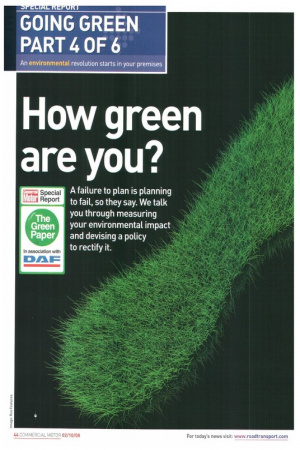How green are you?
Page 44

Page 45

Page 46

If you've noticed an error in this article please click here to report it so we can fix it.
A failure to plan is planning to fail, so they say. We talk you through measuring your environmental impact and devising a policy to rectify it.
If you can't measure it, you can't manage it. The first thing any organisation that is serious about reducing its carbon footprint should do is measure that footprint.
This will show you where the easiest gains can be made, and will also help you to produce a prioritised list of actions you can lake to reduce your carbon output. It is also a chance to look at your bills, your processes and the efficiency of your operation. Put simply, wherever you're wasting anything but time, you're wasting natural resources.
Once you've measured your environmental impact, you need to identify your goals. This is an important step. For many, having an environmental policy will be about saying the right things and having a document to appease customers' corporate social responsibility (CSR) concerns — and that's important. But the fundamental benefit of a policy is that it makes you identify your overall view of the subject, your objectives and your approach. The more clearly you can articulate this to your workforce, the more coherently you will set about implementing it.
Auditing your operation
There are different approaches to be had by auditing your operation. The Government's major focus is on reducing carbon emissions. Thus, carbon footprinting is one of the more readily available tools. A true environmental audit, though, will examine all your processes and consumption with a view to minimising impact on neighbours, protecting the air quality in the immediate locality and natural resources; and minimising waste, noise and odour production.
Carbon footprinting
One of the challenges for the carbon economy has been to agree a standard protocol for calculating carbon output.
For smaller firms that are unlikely to seek external certification of their green efforts, a standard web-based calculator may be suitable (see over).
However, larger companies should be aware of the GHG protocol (www. ghgprotocol.orgi) — this is the emerging international standard.
Another emerging standard closely allied with the GHG protocol is IS014064. Any environmental auditing tools or companies you use should adhere to these standards. That said, you can set your own methodology, but it may limit the external credibility of your work.
In addition, the accepted greenhouse gas conversion values (ie how much a unit of power emits) in the UK are set by Defra and are available on the Defra and the Carbon Trust websites. The Government focuses on CO, and CO2 equivalent (expressed as CO,e) values. However, there are other pollutants and greenhouse gases that daily life and commerce emit into the atmosphere. It is your choice whether you wish to narrow your focus to CO, or use a wider measure.
Once you have established which methodology to work to, you can perform a basic calculation fairly quickly by looking at on-site energy usage, including gas, electricity, heating oil and vehicle fuel.
However, this isn't the total footprint of an organisation. Indirect emissions, including from product and vehicle suppliers, subcontractors and employees travelling to
work, all have an impact. Decide whether to include leased or short-term hire vehicles or subsidiaries. For most companies, calculating the cost of these emissions and reducing them is a secondary project.
Keep in mind that your calculations must include all your vehicles, depots, warehouses, workshops, cold stores and offices. It must also include any cars driven on company business. flights and train journeys. And remember, the function of an environmental audit is to lay a clear, consistent and verifiable baseline to guide and to measure improvements against.
Writing a policy
A policy is designed to express your approach to a subject clearly and concisely. Begin by stating the facts — that transport, while improving daily, contributes significantly to greenhouse gas emissions, which are implicated in global warming.
Next. you should outline your belief. For example, that your company wishes to perform in a manner that supports the local community and global environment. The remainder of the document can be as simple as a statement to: • Reduce your operational impact in the environment • Reduce your usage of natural and manufactured resources • Recycle all possible elements of waste product and safely dispose of the rest • Monitor and improve your environmental performance The level of detail you gjve as to how you will address these issues is up to you, but this is the perfect chance to underline to yourself, staff and customers that environmental responsibility is not bolted on to your operation, but is a fundamental principle of how you do business. It may be good to illustrate your policy with key achievements.
Are you committing to reducing your carbon, to a broadbrush good-neighbour approach, or to pushing the limits and achieving carbon negativity?
Make a realistic decision — you must live up to it. Ensure the policy is readily accessible to everyone, part of all staff inductions and that a nominated person has responsibility for ensuring compliance with it.
The Road Haulage Association (www.rha.net) offers members an environmental policy that can be amended and rebranded to suit the organisation. Most organisations have their environmental policies on their websites — read a few and see what impresses.
Offsetting
It is tempting to overplay carbon offsetting in an environmental policy, because planting a forest somewhere has the same whimsical and appealing ring as sponsoring an orphanage — it hard to see how it can be anything but good PR. But tread carefully, because offsetting can bite you in more ways than one. The first problem is that it isn't environmentally sustainable to waste resources and then compensate for that waste. You must have ensured that the use of resources and thc production of greenhouse gases are driven as low as possible before offsetting the remaining amount.
It is impossible, however, particularly for a transport company, not to emit CO., and so carbon neutrality can be achieved only through some off-setting. However, as always, you must be careful. Use schemes whose offsets are properly calculated and sustainable — Defra's first approved offsetters are due to be announced (www.defra.gov.uk/ environment/climatechange/uk/carbonoffset/links.htm).
In the meantime, its code of practice advice for choosing an offsetter can be found at www.defra.gov.uld environment/dimateclumge/uk/carbonoffset/ codeofpractice.htm. While the Government thinks about it, 50 international non-governmental bodies, including World Wildlife Foundation, have chosen the Gold Standard as the peak offset rating (www.cdmgoldstandard. org/uploads/file/GS_brochure_117 web2.pdf).
Choose an offset that coincides with your firm's values. For example, it may feel more natural for a transport company to fund renewable fuel than to renew a forest. •




































































































































































